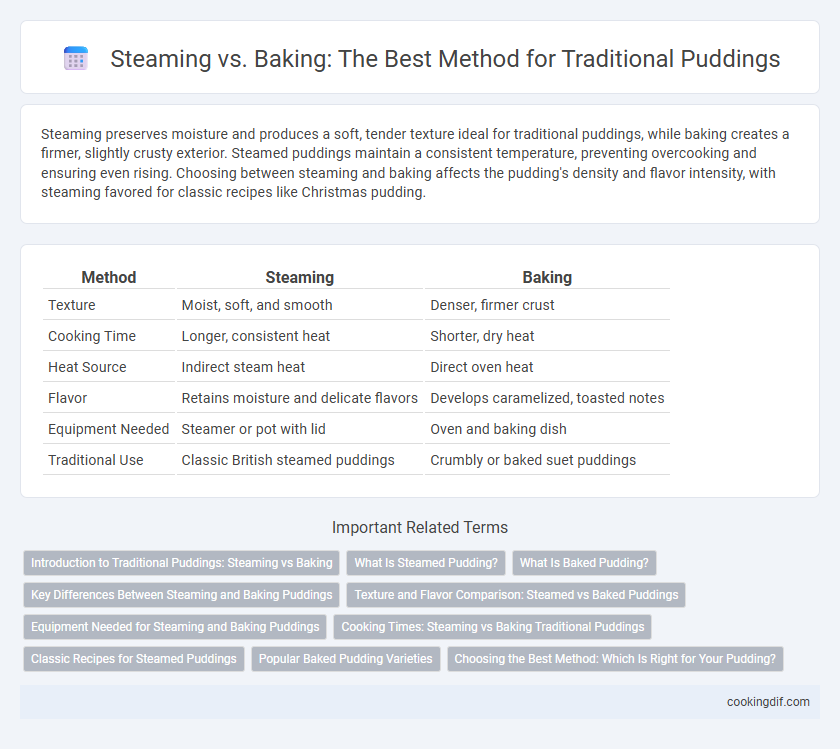Steaming preserves moisture and produces a soft, tender texture ideal for traditional puddings, while baking creates a firmer, slightly crusty exterior. Steamed puddings maintain a consistent temperature, preventing overcooking and ensuring even rising. Choosing between steaming and baking affects the pudding's density and flavor intensity, with steaming favored for classic recipes like Christmas pudding.
Table of Comparison
| Method | Steaming | Baking |
|---|---|---|
| Texture | Moist, soft, and smooth | Denser, firmer crust |
| Cooking Time | Longer, consistent heat | Shorter, dry heat |
| Heat Source | Indirect steam heat | Direct oven heat |
| Flavor | Retains moisture and delicate flavors | Develops caramelized, toasted notes |
| Equipment Needed | Steamer or pot with lid | Oven and baking dish |
| Traditional Use | Classic British steamed puddings | Crumbly or baked suet puddings |
Introduction to Traditional Puddings: Steaming vs Baking
Traditional puddings often rely on steaming or baking as primary cooking methods that influence texture and flavor. Steaming preserves moisture and results in a dense, silky consistency ideal for suet-based puddings, while baking typically creates a firmer, more cake-like texture suitable for bread or sponge puddings. Understanding these methods helps optimize moisture retention and enhances the characteristic richness of classic puddings, such as Christmas pudding or treacle sponge.
What Is Steamed Pudding?
Steamed pudding is a classic British dessert cooked by placing the batter or mixture into a cloth or heatproof basin, which is then sealed and steamed over boiling water for several hours. This method produces a moist, dense texture with a rich flavor that differs significantly from baking, which uses dry heat to create a firmer, often crisper surface. Steaming retains more moisture, making traditional puddings like treacle or Christmas pudding distinctly soft and succulent compared to baked varieties.
What Is Baked Pudding?
Baked pudding refers to a traditional dessert cooked in an oven, where the batter or mixture solidifies through dry heat, resulting in a dense and often caramelized texture. Unlike steaming, baking develops a firmer crust and deeper flavors due to Maillard reactions occurring at higher temperatures. This method is commonly used for bread puddings and suet puddings, enhancing ingredients like dried fruits and custard bases with rich, toasted notes.
Key Differences Between Steaming and Baking Puddings
Steaming traditional puddings preserves moisture, resulting in a soft, tender texture, while baking creates a firmer, denser consistency with a slightly browned exterior. Steamed puddings cook evenly through gentle heat and steam, preventing drying out, whereas baked puddings rely on dry heat that can develop a crust. The steaming method suits suet and sponge puddings, maintaining lightness, while baking is preferred for bread or fruit puddings requiring structure.
Texture and Flavor Comparison: Steamed vs Baked Puddings
Steamed puddings retain moisture, resulting in a dense, smooth, and velvety texture that enhances the richness of ingredients like suet and dried fruits. Baked puddings develop a slightly firmer outer crust with a lighter, airier interior, offering a contrast in mouthfeel and intensified caramelized flavors. The steaming method preserves subtle sweetness and a deep, moist consistency, while baking promotes a more pronounced golden-brown aroma and texture variation.
Equipment Needed for Steaming and Baking Puddings
Steaming traditional puddings requires a large pot or steamer with a tight-fitting lid, pudding basin or heatproof bowl, and kitchen twine or foil to cover the pudding securely. Baking puddings involves using an oven-safe dish, a water bath or roasting tin filled with hot water to maintain moisture, and sometimes a lid or foil to prevent drying. Proper equipment ensures even cooking and the characteristic texture of steamed or baked puddings.
Cooking Times: Steaming vs Baking Traditional Puddings
Steaming traditional puddings typically requires longer cooking times, often ranging from 1.5 to 3 hours, as the moist heat ensures even cooking and prevents drying out. Baking puddings generally takes less time, around 45 minutes to 1.5 hours, but can risk a drier texture due to direct heat exposure. The choice between steaming and baking significantly impacts the moisture retention and final texture of traditional puddings.
Classic Recipes for Steamed Puddings
Steaming classic puddings preserves moisture, resulting in a soft, dense texture essential for traditional British recipes like spotted dick and treacle pudding. Unlike baking, which can create a drier, firmer crust, steaming ensures even cooking by surrounding the batter with moist heat, maintaining the pudding's rich flavor and tender crumb. Time-tested steamed pudding techniques highlight the importance of slow, gentle heat for the perfect balance of sweetness and texture in these iconic desserts.
Popular Baked Pudding Varieties
Steaming preserves moisture in traditional puddings, creating a soft, custard-like texture, while baking produces a firmer, golden crust prized in popular varieties such as bread pudding and sticky toffee pudding. Baked puddings like treacle sponge and fruit cobblers develop caramelized tops that enhance flavor complexity and visual appeal. The choice between steaming and baking significantly influences the pudding's texture, taste profile, and presentation.
Choosing the Best Method: Which Is Right for Your Pudding?
Steaming preserves moisture and creates a smooth, tender texture essential for traditional puddings like Christmas pudding or sticky toffee pudding. Baking offers a firmer crust and a richer, caramelized flavor, ideal for suet puddings or bread puddings. Selecting the best method depends on the desired texture and flavor profile, with steaming excelling in moist consistency and baking enhancing depth and structure.
Steaming vs baking for traditional puddings Infographic

 cookingdif.com
cookingdif.com